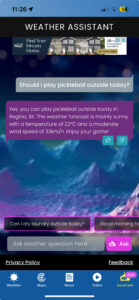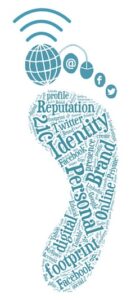 The AI tool I chose to look at is something that can be very helpful to everyones day to day life, the AI Weather Assistant is a great tool that you can ask personalized questions to regarding the weather. I chose to ask the Weather Assistant if I should play pickleball outside today and it told me, yes the weather in Regina today would be great for that! You can also ask it to recommend outfit choices, based on the weather around you.
The AI tool I chose to look at is something that can be very helpful to everyones day to day life, the AI Weather Assistant is a great tool that you can ask personalized questions to regarding the weather. I chose to ask the Weather Assistant if I should play pickleball outside today and it told me, yes the weather in Regina today would be great for that! You can also ask it to recommend outfit choices, based on the weather around you.

Integrating AI into education offers exciting opportunities to enhance personalized individualized learning plans/goals, and provide support systems that perfectly adapt to individual student needs. AI can analyze data to offer insights into student performance, recommend resources, and automate tasks such as grading. The future of AI in the classroom looks promising and exciting. However, it is crucial to address privacy concerns and ensure ethical use of data, while teaching students the proper way to use AI technology. Improper use and abuse of technology With thoughtful implementation, AI can significantly enrich the learning environment, provided it is used responsibly and not abused.
I would personally use this tool during the school day for a variety of reasons, I would use it to ask about having class outside and whether it is recommend or not. I would also use it to ask what kind of clothing my students should wear for recess or a class walk outside. Being I commute 45 minutes to my job and living in Saskatchewan, knowing the weather conditions is crucial, making this tool frequently used on my phone!
 Throughout this course, I was able to connect with my classmates on a different level than most classes, where you mostly communicate through forum post/comment section. I was able to leave helpful comments throughout my peers posts and allowed myself to express opinions when necessary. Though, I did not keep up the best with my peers blogs, I was always able to fully emerge into the content that was being taught in class, engage in meaningful discussions all while fostering an educator relationship, where respect and mutual gain are the main goals.
Throughout this course, I was able to connect with my classmates on a different level than most classes, where you mostly communicate through forum post/comment section. I was able to leave helpful comments throughout my peers posts and allowed myself to express opinions when necessary. Though, I did not keep up the best with my peers blogs, I was always able to fully emerge into the content that was being taught in class, engage in meaningful discussions all while fostering an educator relationship, where respect and mutual gain are the main goals.

 The AI tool I chose to look at is something that can be very helpful to everyones day to day life, the AI Weather Assistant is a great tool that you can ask personalized questions to regarding the weather. I chose to ask the Weather Assistant if I should play pickleball outside today and it told me, yes the weather in Regina today would be great for that! You can also ask it to recommend outfit choices, based on the weather around you.
The AI tool I chose to look at is something that can be very helpful to everyones day to day life, the AI Weather Assistant is a great tool that you can ask personalized questions to regarding the weather. I chose to ask the Weather Assistant if I should play pickleball outside today and it told me, yes the weather in Regina today would be great for that! You can also ask it to recommend outfit choices, based on the weather around you.


